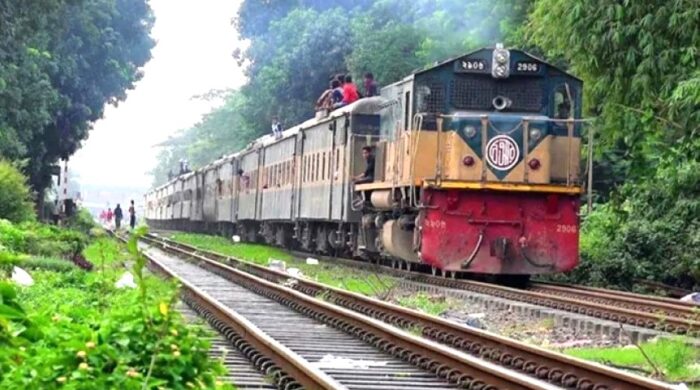
A total of 23 out of 60 trains at 13 routes in the Western Zone (WZ) of Bangladesh Railway have been out of operation for almost 19 years, with no sign of an immediate return.
Railway officials cries several reasons behind for this prolonged suspension including severe losses in the passenger segment as well as shortages of crew members, guards, locomotives and coaches.
A recent request from the central office of Bangladesh Railway prompted a detailed breakdown of these suspended services, with explanations submitted for each.
Insiders confirm that persistent budget shortfalls have hampered any meaningful progress on resolve the issues. The acquisition of new locomotives, a key part of the solution, remains a complex and time-consuming process, according to report.
Besides, despite the setbacks, railway WZ officials asserted that they are working tirelessly to continue providing service where possible.
Meanwhile, thousands of passengers—mostly working-class and low-income individuals—have been facing immense difficulties due to the lack of service. Passenger pressure on the remaining local and commuter trains has increased significantly, forcing many to travel standing or even climbing onto train rooftops. Intercity trains are also experiencing extra burden of surge in regular passengers as a result.
Passenger train services have been suspended on the following routes:
Tangail via Bangabandhu Bridge (Train No. 515), Tangail–Kamalapur via Bangabandhu Bridge (Train No. 511), Kamalapur–Chandpur (Train No. 541), Chandpur–Laksam (Train No. 591), Laksam–Chandpur (Train No. 592), Chandpur–Kamalapur (Train No. 542), Kamalapur–Tangail (Train No. 512) since January 18, 2012; Joydebpur–Elenga–Joydebpur (Train Nos. 451/452) since August 12, 2006; Chandpur–Ex.G.M.B–Chandpur (Train Nos. 413/414) and Joydebpur–Chandpur–Joydebpur (Train Nos. 413/414) since January 1, 2009; Joydebpur–Chandpur–Joydebpur (Train Nos. 411/412) and Joydebpur–Elenga–Joydebpur (Train Nos. 453/454) since October 16, 2010; Chandpur–Ex.G.M.B–Chandpur (Train Nos. 431/434) since October 15, 2011.
These trains were suspended citing reasons related to fuel and manpower shortages.
Chandpur–Joydebpur–Chandpur (Train Nos. 69/70) since July 1, 2011; Joydebpur–Mymensingh–Joydebpur (Train Nos. 481/482) since January 18, 2012—these services were also stopped due to fuel shortages, according to sources.
Mymensingh–Ex.G.M.B–Mymensingh (Local Train No. 7/8) was suspended on March 19, 2021, also due to fuel and manpower issues.
Joydebpur–Chandpur–Joydebpur (Special Train Nos. 1/2) was suspended on February 18, 2023, while Chandpur–Ex.G.M.B–Chandpur (Special Train Nos. 1/2) was suspended on October 24, 2020. These services were reportedly halted to allow regular maintenance.
Additionally, new trains such as Ishwardi–Bheramara–Dhaka–Bheramara–Ishwardi (Train Nos. 121/124, 123/122) are scheduled to begin operating from March 13, 2024, and the Kamalapur–Ishurdi–Kamalapur (Intercity Train Nos. 563/564) service was discontinued on January 14, 2023.
There is a possibility of reintroducing the Kamalapur–Ishurdi–Kamalapur route in the future, but no final decision has been made yet.
Widespread Passenger Hardship
The suspension of services has led to widespread inconvenience and distress among daily commuters. Overcrowding is now a daily reality in every routes and more passengers are forced to travel on rooftops, increasing safety risks. Some have resorted to alternative transport modes like buses, despite higher costs and added inconvenience.
During a recent visit to Rajshahi Railway Station, a passenger named Farukuzzaman Khan shared his frustration that the Uttara Express has been inactive for over a year.
“It was a lifeline for low-income travellers like us. Now we are forced to use more expensive alternatives, which is both costly and troublesome,” the man lamented.
Official’s versions/
Abdul Awal, Assistant Chief Operating Superintendent of the Western Railway, said the train closures were primarily due to shortages in locomotives (engines) and drivers.
Western Railway’s General Manager Abdul Awal Bhuiyan acknowledged the staff shortages but added that some new trains have been introduced alongside the suspended ones.
Several officials, speaking anonymously, suggested that Bangladesh Railway suffers from a lack of strategic planning and dwindling capacity to restart services once halted. Alarmingly, they noted that more than half of the railway’s locomotives have surpassed their economic life expectancy, with some engines exceeding 20 years in operation.
Bangladesh Railway Director General Afzal Hossain admitted the severity of the issues, particularly in engine procurement.
“It’s not like we can just pay and pick up engines from the market,” he explained.
“Ordering a new engine takes at least two to three years. It also requires funding from development partners since this doesn’t fall under the regular revenue budget.”
According to this official, Bangladesh Railway currently needs around 90 new locomotives across both meter and broad-gauge tracks. Plans are underway to purchase 30 new meter-gauge engines in the first phase with financing from the Asian Development Bank (ADB). Recruitment for new staff is also planned in parallel.
Additional efforts to address other infrastructural and operational gaps will follow in subsequent phases.